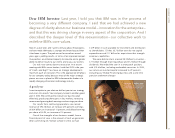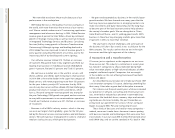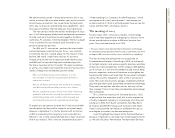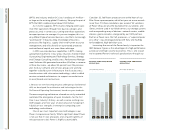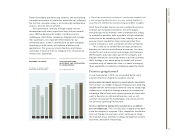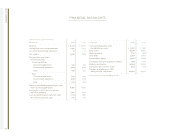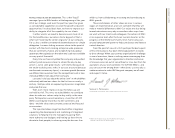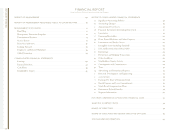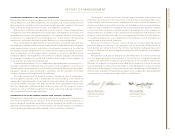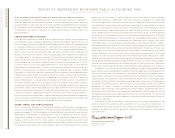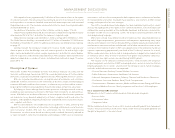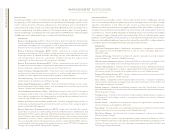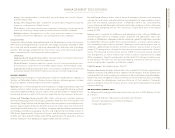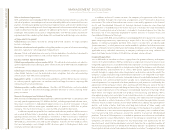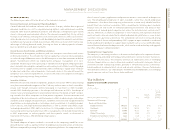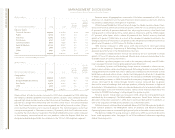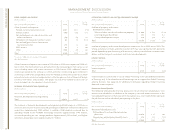IBM 2004 Annual Report Download - page 13
Download and view the complete annual report
Please find page 13 of the 2004 IBM annual report below. You can navigate through the pages in the report by either clicking on the pages listed below, or by using the keyword search tool below to find specific information within the annual report.
MANAGEMENT DISCUSSION
International Business Machines Corporation and Subsidiary Companies
11
ibm annual report 2004
Road Map
The financial section of the International Business Machines Corporation (IBM and/or the
company) 2004 Annual Report, consisting of this Management Discussion, the Consoli-
dated Financial Statements that follow and the notes related thereto, comprises 83 pages
of information. This Road Map is designed to provide you with some perspective regard-
ing the information contained in the financial section and a few helpful hints for reading
the document.
ibm’s business model
The company’s business model is built to support two principal goals: helping clients suc-
ceed in delivering business value by becoming more efficient and competitive through
the use of business insight and information technology (IT) solutions; and providing long-
term value to shareholders. In support of these objectives, the business model has been
developed over time through strategic investments in services and technologies that have
the best long-term growth and profitability prospects based on the value they deliver to
clients. In addition, the company is committed to its employees and the communities in
which it operates.
The model is designed to allow for flexibility and periodic rebalancing. In 2004,
14 acquisitions were completed, all in software and services, at an aggregate cost of over
$2 billion, and in the fourth quarter the company announced the agreement to sell its
Personal Computing Division, a unit of the Personal Systems Group.
The company’s portfolio of capabilities ranges from services that include business
performance transformation services to software, hardware, fundamental research, financ-
ing and the component technologies used to build larger systems. These capabilities are
combined to provide business insight and solutions in the enterprise computing space.
In terms of financial performance, over the last two years, the company has increased
its participation in the high-growth areas of its industry, while at the same time maintaining
a breadth of capabilities that has allowed it to gain share in key markets during changing
economic environments. In general, this strategy results in less volatile returns overall,
because each individual capability has unique financial attributes. Some involve contractual
long-term cash and income streams while others involve cyclical transaction-based sales.
The annuity-like business delivers incremental growth with a high degree of stability and
provides substantial cash. New engagements deliver more significant revenue growth and
require a level of investment to generate success.
In terms of marketplace performance— i.e., the ability to deliver client value— it is
important to understand that the fundamental strength of this business model is not found
in the breadth of the portfolio alone, but in the way the company creates business solu-
tions from among its capabilities and relationships.
transparency
Transparency is a primary goal of successful financial reporting. The following are the key
elements you will find in this year’s Annual Report.
•In 2004, the company, in accordance with Section 404 of the Sarbanes-Oxley Act of
2002, conducted an evaluation of its internal control over financial reporting and
concluded that the internal control over financial reporting was effective as of
December 31, 2004.
•The Management Discussion is designed to provide readers with a view of the com-
pany’s results and certain factors that may affect future prospects from the perspective
of the company’s management. Within the Management Discussion Snapshot, the
key messages and details will give readers the ability to quickly assess the most
important drivers of performance within this brief overview.
•The Management Discussion reflects the company’s continued and improving strength
in providing broad client solutions, as opposed to a “piece parts” conglomeration of
many hardware, software and services businesses. The Description of the Business on
page 13, Results of Continuing Operations on page 17, Financial Position on page
23, and Looking Forward on page 28 sections, all are written from the perspective
of the consolidated entity. Detailed analysis for each of the company’s segments is
also included and appears on pages 21 to 23.
•Global Financing is a business segment within the company that is managed on an
arm’s-length basis and measured as if it were a standalone entity. A separate Global
Financing section beginning on page 35 is not included in the consolidated perspec-
tive that is referred to above. This section is separately presented given this segment’s
unique impact on the company’s financial condition and leverage.
•The selected reference to constant currency in the Management Discussion is made
so that the financial results can be viewed without the impacts of changing foreign
currency exchange rates and therefore facilitates a comparative view of business
growth. The percentages reported in the financial tables throughout the Management
Discussion are calculated from the underlying whole-dollar numbers. See “Currency
Rate Fluctuations” on page 33 for additional information.
helpful hints
Organization of Information
•This Management Discussion section provides the reader of the financial statements
with a narrative on the company’s financial results. It contains the results of operations
for each segment of the business, followed by a description of the company’s finan-
cial position, as well as certain employee data. It is useful to read the Management
Discussion in conjunction with note x, “Segment Information,” on pages 87 through 91.
•Pages 40 through 48 include the Consolidated Financial Statements. These statements
provide an overview of the company’s income and cash flow performance and its
financial position.
•The notes follow the Consolidated Financial Statements. Among other things, the notes
contain the company’s accounting policies (pages 49 to 55), detailed information on
specific items within the financial statements, certain contingencies and commit-
ments (pages 69 to 71), and the results of each IBM segment (pages 87 through 91).


